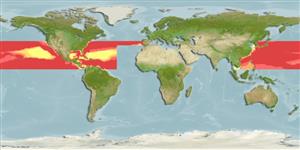Environment: milieu / climate zone / depth range / distribution range
Ökologie
seewasser; brackwasser; ozeanodrom (Ref. 51243); tiefenbereich 0 - 1281 m (Ref. 58018). Subtropical; 41°N - 7°N
Atlantic Ocean: Canada (Ref. 5951) to New Jersey, USA to northern South America (Ref. 7251); reported from southern Africa. Also Indian and Pacific oceans.
Size / Gewicht / Alter
Maturity: Lm ? range ? - ? cm
Max length : 30.0 cm SL Männchen/unbestimmt; (Ref. 48637)
Rückenflossenstacheln (insgesamt) : 10 - 12; Rückenflossenweichstrahlen (insgesamt) : 22 - 24; Afterflossenstacheln: 3; Afterflossenweichstrahlen: 21 - 23; Wirbelzahl: 34 - 38. Brown with darker brown vertical bands (Ref. 4412).
Epipelagic or mesopelagic in oceanic temperate waters. Rarely seen (Ref. 6891). Juveniles swim among tentacles of jellies (Ref. 48637).
Life cycle and mating behavior
Geschlechtsreife | Fortpflanzung | Ablaichen | Eier | Fecundity | Larven
Haedrich, R.L., 1986. Nomeidae. p. 846-850. In M.M. Smith and P.C. Heemstra (eds.) Smiths' sea fishes. Springer-Verlag, Berlin. (Ref. 4412)
IUCN Rote Liste Status (Ref. 130435: Version 2024-1)
Bedrohung für Menschen
Harmless
Nutzung durch Menschen
Tools
Zusatzinformationen
Download XML
Internet Quellen
Estimates based on models
Preferred temperature (Ref.
123201): 1.8 - 18.1, mean 11.5 °C (based on 404 cells).
Phylogenetic diversity index (Ref.
82804): PD
50 = 0.5313 [Uniqueness, from 0.5 = low to 2.0 = high].
Bayesian length-weight: a=0.01995 (0.00906 - 0.04395), b=3.01 (2.83 - 3.19), in cm total length, based on all LWR estimates for this body shape (Ref.
93245).
Trophic level (Ref.
69278): 3.6 ±0.5 se; based on size and trophs of closest relatives
Widerstandsfähigkeit (Ref.
120179): mittel, Verdopplung der Population dauert 1,4 - 4,4 Jahre. (Assuming tm=2-4).
Fishing Vulnerability (Ref.
59153): Low to moderate vulnerability (27 of 100).
